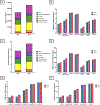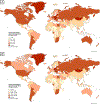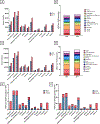Rising global burden of cancer attributable to high BMI from 2010 to 2019
- PMID: 38029839
- PMCID: PMC11321712
- DOI: 10.1016/j.metabol.2023.155744
Rising global burden of cancer attributable to high BMI from 2010 to 2019
Abstract
Background: High body mass index (BMI) is a major risk factor for cancer development, but its impact on the global burden of cancer remains unclear.
Methods: We estimated global and regional temporal trends in the burden of cancer attributable to high BMI, and the contributions of various cancer types using the framework of the Global Burden of Disease Study.
Results: From 2010 to 2019, there was a 35 % increase in deaths and a 34 % increase in disability-adjusted life-years from cancers attributable to high BMI. The age-standardized death rates for cancer attributable to high BMI increased over the study period (annual percentage change [APC] +0.48 %, 95 % CI 0.22 to 0.74 %). The greatest number of deaths from cancer attributable to high BMI occurred in Europe, but the fastest-growing age-standardized death rates and disability-adjusted life-years occurred in Southeast Asia. Liver cancer was the fastest-growing cause of cancer mortality (APC: 1.37 %, 95 % CI 1.25 to 1.49 %) attributable to high BMI.
Conclusion: The global burden of cancer-related deaths attributable to high BMI has increased substantially from 2010 to 2019. The greatest increase in age-standardized death rates occurred in Southeast Asia, and liver cancer is the fastest-growing cause of cancer mortality attributable to high BMI. Urgent and sustained measures are required at a global and regional level to reverse these trends and slow the growing burden of cancer attributed to high BMI.
Keywords: Cancer; Epidemiology; Etiology; Obesity.
Copyright © 2023 Elsevier Inc. All rights reserved.
Conflict of interest statement
Declaration of competing interest Rohit Loomba: receives funding support from NIEHS (5P42ES010337), NCATS (5UL1TR001442), NIDDK (U01DK130190, U01DK061734, R01DK106419, P30DK120515, R01DK121378, R01DK124318), and NHLBI (P01HL147835). RL serves as a consultant to Aardvark Therapeutics, Altimmune, Anylam/Regeneron, Amgen, Arrowhead Pharmaceuticals, AstraZeneca, Bristol-Myer Squibb, CohBar, Eli Lilly, Galmed, Gilead, Glympse bio, Hightide, Inipharma, Intercept, Inventiva, Ionis, Janssen Inc., Madrigal, Metacrine, Inc., NGM Biopharmaceuticals, Novartis, Novo Nordisk, Merck, Pfizer, Sagimet, Theratechnologies, 89 bio, Terns Pharmaceuticals and Viking Therapeutics. In addition, his institutions received research grants from Arrowhead Pharmaceuticals, Astrazeneca, Boehringer-Ingelheim, Bristol-Myers Squibb, Eli Lilly, Galectin Therapeutics, Galmed Pharmaceuticals, Gilead, Intercept, Hanmi, Intercept, Inventiva, Ionis, Janssen, Madrigal Pharmaceuticals, Merck, NGM Biopharmaceuticals, Novo Nordisk, Merck, Pfizer, Sonic Incytes and Terns Pharmaceuticals. Co-founder of LipoNexus Inc. KG Yeoh: receive research grants from Singapore Ministry of Health's National Medical Research Council (MOH-OFLCG18May-0003) and A*STAR (IAF-ICP I2101E0012). He is a member of the Scientific Advisory Board of MiRXES in an honorary capacity and receives no personal payments. Daniel Q Huang: receives funding support from the Singapore Ministry of Health's National Medical Research Council under its NMRC Research Training Fellowship (MOH-000595-01). In addition, he has served as an advisory board member for Gilead. Christos S. Mantzoros: CSM reports grants through his institution from Merck, Massachusetts Life Sciences Center and Boehringer Ingellheim, has been a shareholder of and has received grants through his Institution and personal consulting fees from Coherus Inc. and AltrixBio, he reports personal consulting fees from Novo Nordisk, reports personal consulting fees and support with research reagents from Ansh Inc., collaborative research support from LabCorp Inc., reports personal consulting fees from Genfit, Lumos, Amgen, Corcept, Intercept, 89 Bio, Madrigal and Regeneron, reports educational activity meals through his institution or national conferences from Esperion, Merck, Boehringer Ingelheim and travel support and fees from TMIOA, Elsevier, and the Cardio Metabolic Health Conference. None is related to the work presented herein. Cheng Han Ng: CHN has served as a consultant to Boxer Capital. All other authors do not have any conflicts of interest.
Figures



References
-
- Calle EE, Kaaks R. Overweight, obesity and cancer: epidemiological evidence and proposed mechanisms. Nat Rev Cancer 2004;4(8):579–91. - PubMed

